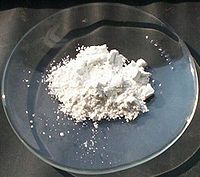Senarmontite
 |
|
| Names | |
|---|---|
|
IUPAC name
Antimony(III) oxide
|
|
| Other names | |
| Identifiers | |
|
1309-64-4 |
|
| 3D model (Jmol) | Interactive image |
| ChemSpider |
25727 |
| ECHA InfoCard | 100.013.796 |
| KEGG |
C19192 |
| RTECS number | CC5650000 |
| UNII |
P217481X5E |
|
|
|
|
| Properties | |
| Sb2O3 | |
| Molar mass | 291.518 g/mol |
| Appearance | white solid |
| Odor | odorless |
| Density | 5.2 g/cm3, α-form 5.67 g/cm3 β-form |
| Melting point | 656 °C (1,213 °F; 929 K) |
| Boiling point | 1,425 °C (2,597 °F; 1,698 K) (sublimes) |
| Dissolved concentration of 370 ± 37 µg/L was obtained with a loading of 10 mg/L after 7 days of exposure. Temperature varied between 20.8°C (t=0; start of the test) and 22.9°C | |
| Solubility | soluble in acid |
| -69.4·10−6 cm3/mol | |
|
Refractive index (nD)
|
2.087, α-form 2.35, β-form |
| Structure | |
|
cubic (α)<570 °C orthorhombic (β) >570 °C |
|
| pyramidal | |
| zero | |
| Hazards | |
| Safety data sheet | See: data page |
|
EU classification (DSD)
|
Harmful (Xn) Carc. Cat. 2 (H351) |
| R-phrases | R40 |
| S-phrases | (S2), S22, S36/37 |
| NFPA 704 | |
| Lethal dose or concentration (LD, LC): | |
|
LD50 (median dose)
|
7000 mg/kg, oral (rat) |
| US health exposure limits (NIOSH): | |
|
PEL (Permissible)
|
TWA 0.5 mg/m3 (as Sb) |
|
REL (Recommended)
|
TWA 0.5 mg/m3 (as Sb) |
| Related compounds | |
|
Other anions
|
Antimony trisulfide |
|
Other cations
|
Bismuth trioxide |
|
Related compounds
|
Diantimony tetraoxide Antimony pentoxide |
| Supplementary data page | |
|
Refractive index (n), Dielectric constant (εr), etc. |
|
|
Thermodynamic
data |
Phase behaviour solid–liquid–gas |
| UV, IR, NMR, MS | |
|
Except where otherwise noted, data are given for materials in their standard state (at 25 °C [77 °F], 100 kPa).
|
|
|
|
|
| Infobox references | |
Antimony(III) oxide is the inorganic compound with the formula Sb2O3. It is the most important commercial compound of antimony. It is found in nature as the minerals valentinite and senarmontite. Like most polymeric oxides, Sb2O3 dissolves in aqueous solutions with hydrolysis.
Global production of antimony(III) oxide in 2012 was 130,000 tonnes, an increase from 112,600 tonnes in 2002. China produces the largest share followed by US/Mexico, Europe, Japan and South Africa and other countries (2%).
As of 2010, antimony(III) oxide was produced at four sites in EU27. It is produced via two routes, re-volatilizing of crude antimony(III) oxide and by oxidation of antimony metal. Oxidation of antimony metal dominates in Europe. Several processes for the production of crude antimony(III) oxide or metallic antimony from virgin material. The choice of process depends on the composition of the ore and other factors. Typical steps include mining, crushing and grinding of ore, sometimes followed by froth flotation and separation of the metal using pyrometallurgical processes (smelting or roasting) or in a few cases (e.g. when the ore is rich in precious metals) by hydrometallurgical processes. These steps do not take place in the EU but closer to the mining location.
Step 1) Crude stibnite is oxidized to crude antimony(III) oxide using furnaces operating at approximately 500 to 1,000 °C. The reaction is the following:
Step 2) The crude antimony(III) oxide is purified by sublimation.
Antimony metal is oxidized to antimony(III) oxide in furnaces. The reaction is exothermic. Antimony(III) oxide is formed through sublimation and recovered in bag filters (bag house). The size of the formed particles is controlled by process conditions in furnace and gas flow. The reaction can be schematically described by:
Antimony(III) oxide is an amphoteric oxide, it dissolves in aqueous sodium hydroxide solution to give the meta-antimonite NaSbO2, which can be isolated as the trihydrate. Antimony(III) oxide also dissolves in concentrated mineral acids to give the corresponding salts, which hydrolyzes upon dilution with water. With nitric acid, the trioxide is oxidized to antimony(V) oxide.
...
Wikipedia

